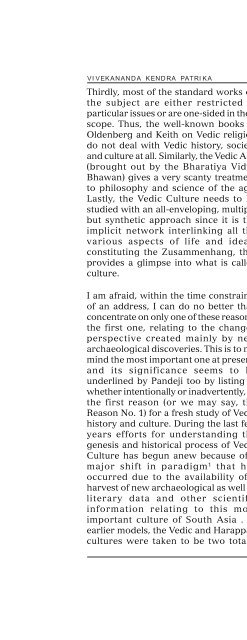Aryan Invasion Theory - Publication - Vivekananda Kendra
Aryan Invasion Theory - Publication - Vivekananda Kendra
Aryan Invasion Theory - Publication - Vivekananda Kendra
You also want an ePaper? Increase the reach of your titles
YUMPU automatically turns print PDFs into web optimized ePapers that Google loves.
VIVEKANANDA KENDRA PATRIKA<br />
Thirdly, most of the standard works on<br />
the subject are either restricted to<br />
particular issues or are one-sided in their<br />
scope. Thus, the well-known books of<br />
Oldenberg and Keith on Vedic religion<br />
do not deal with Vedic history, society<br />
and culture at all. Similarly, the Vedic Age<br />
(brought out by the Bharatiya Vidya<br />
Bhawan) gives a very scanty treatment<br />
to philosophy and science of the age.<br />
Lastly, the Vedic Culture needs to be<br />
studied with an all-enveloping, multiple<br />
but synthetic approach since it is the<br />
implicit network interlinking all the<br />
various aspects of life and ideas,<br />
constituting the Zusammenhang, that<br />
provides a glimpse into what is called<br />
culture.<br />
I am afraid, within the time constraints<br />
of an address, I can do no better than<br />
concentrate on only one of these reasons,<br />
the first one, relating to the changed<br />
perspective created mainly by new<br />
archaeological discoveries. This is to my<br />
mind the most important one at present,<br />
and its significance seems to be<br />
underlined by Pandeji too by listing it,<br />
whether intentionally or inadvertently, as<br />
the first reason (or we may say, the<br />
Reason No. 1) for a fresh study of Vedic<br />
history and culture. During the last few<br />
years efforts for understanding the<br />
genesis and historical process of Vedic<br />
Culture has begun anew because of a<br />
major shift in paradigm 1 that has<br />
occurred due to the availability of a<br />
harvest of new archaeological as well as<br />
literary data and other scientific<br />
information relating to this most<br />
important culture of South Asia . In<br />
earlier models, the Vedic and Harappan<br />
cultures were taken to be two totally<br />
11<br />
ARYAN INVASION THEORY<br />
different cultures. Most of the scholars<br />
believed that while the former was <strong>Aryan</strong>,<br />
the latter was non-<strong>Aryan</strong> (Dravidian).<br />
The Vedic Culture was supposed to be<br />
chronologically later than, and<br />
qualitatively inferior to, the Harappan<br />
Civilization. The Vedic Culture was not<br />
accorded even the status of a ‘civilization’<br />
since by definition2 the culture of an<br />
urbanized and literate society alone could<br />
be designated as a ‘civilization’, and the<br />
Vedic people were presumed to be<br />
illiterate village folk ignorant of city life.<br />
So powerful was the hold of the earlier<br />
paradigm that a prestigious UNESCO<br />
publication, History of Mankind, labelled<br />
the <strong>Aryan</strong>s as a ‘non-urbanized people<br />
and semi-barbarous’ who destroyed the<br />
non-<strong>Aryan</strong> Harappan Civilization<br />
(Hawkes and Wooley 1963:406). But, now<br />
the perceptive is totally changed. The<br />
Vedic-Harappan dichotomy is being<br />
rejected with accumulating evidence that<br />
point to the contrary and establish their<br />
identity. While Bhagwan Singh has come<br />
out with two well-documented works<br />
(1987/97; 1995) in support of this identity,<br />
several other scholars like B. B. Lal<br />
(1997:281-87; 2001-02; 2002) and S. P.<br />
Gupta (1996:137-74) strongly uphold this<br />
equation though they prefer to wait for<br />
the decipherment of the Harappan script<br />
to put a final seal on this identity. This<br />
changed perspective is, indeed, of a very<br />
great consequence for it has opened up<br />
several new dimensions for further<br />
researches in the field of Vedic historical<br />
studies. If the Vedic and Harappan<br />
cultures are actually one and the same,<br />
we have enormous archaeological data<br />
at hand to supplement the knowledge<br />
that we presently have about the Vedic

















